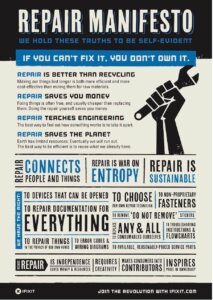I host online discussions about sustainable manufacturing. During one of these events in October that included participants from the 3D InCites community, I asked what topics people wanted to read about in the blog. Someone brought up recycling and repair of smartphones. With increased emphasis on the right to repair, I agreed that this is a worthwhile topic for discussion.
Sustainability Starts with Design
Sustainable design practices cover a wide range of issues. Some of them are directly related to repairability. Consider:
- Where can you improve interoperability with products from other manufacturers to make component replacement easier?
- How long is the product expected to last, and where are the weak links (parts or components most likely to fail first)?
- What can you change to make the product more durable and repairable when something goes wrong?
Product designers play a key role in repairability. They are not, however, the only link in the chain. Let’s look at organizations and regulations that are advancing the cause of repairability.
iFixit Repair Manifesto
The company iFixit is on a mission to make consumer electronics more repairable. They rate devices on a scale of 1 to 10. The easier the device is to open and disassemble, the higher the score. Parts that are glued or soldered in place reduce a device’s rating. Screws are a better choice.

One fun feature on the iFixit website is the tear-downs with photos and videos showing the inside of smartphones and other devices.
The teardown of the iPhone 13 Pro comes with a list of tools they used, including something called a spudger. I had never heard of such a thing. It is a multipurpose antistatic tool for electronics repair. The spudger from the iPhone teardown is made from a carbon fiber composite, so it is tougher and more durable than a plastic spudger.
Fairphone, a modular and upgradeable smartphone, earns top marks, 10 out of 10 on iFixit. Customers can replace the battery and screen without any tools. Individual modules inside the phone can be removed and replaced using a screwdriver.

Right to Repair Laws
One route to incenting behavior change is through legislation. Some regulations, like one in France, give consumers information that makes it easier to choose more repairable devices. Right to Repair laws give repair shops the resources they need to repair products more easily.
The Indice de Réparabilité (repairability index) in France went into effect in 2021. The goal is to inform consumers about the repairability of various products. Electronics in covered categories must display their score to consumers. Initial categories include smartphones, laptops, televisions, washing machines, and lawnmowers. As of November 3, 2022, new categories of household appliances are also covered.
The index rates products on a 10-point scale. The rating considers the ease of disassembly, the availability and pricing of spare parts, technical repair documentation, and any product-specific repair issues.
New York state introduced the first Right to Repair bill in the United States in June 2022. It will go into effect in 2023 and will expand the availability of instruction manuals, replacement parts, and repair tools. Customers will be able to get their electronics fixed at independent repair shops or do it themselves instead of having to rely on manufacturer-authorized providers.
Right to Repair laws and repairability disclosure regulations are under consideration in many other countries. They will, hopefully, encourage manufacturers to make products more repairable and encourage consumers to send their damaged devices for repair instead of to an e-waste recycler. (Or, worse, to a landfill. But 3D InCites readers know better than to dump old electronics into the trash.)
What Does This Mean for 3D Integration?
Everyone reading this blog presumably owns multiple electronic devices (smartphones, laptops, televisions). That means that, as an individual, you can see the importance of repairability. You may have experienced the frustration of electronics that stop working and wish you could fix them quickly.
What do repairability and the right to repair have to do with your work? Here are some ideas to consider:
- Look for ways to catch defects early enough in the manufacturing process to enable rework instead of scrapping wafers or modules.
- Consider what happens to your products when they reach the customer. Can you design them in a way that makes it easier for that customer to make their products more repairable?
- If you make tools, what can you do to make it easier for your customers to get them running again if something malfunctions?
Also, realize that your company’s products probably appear somewhere in the consumer electronics supply chain. They may not end up inside the device. Perhaps they help design, assemble, or inspect it. You may be able to indirectly improve the durability and reliability of electronic devices so that they last longer before needing repair.
You have two voices, one as a buyer of electronic devices and another as a supplier that plays a role in designing or manufacturing those devices. Both those voices can weigh in on repairability. Plus, your voice as a member of 3D InCites can influence what appears in this blog series.




















